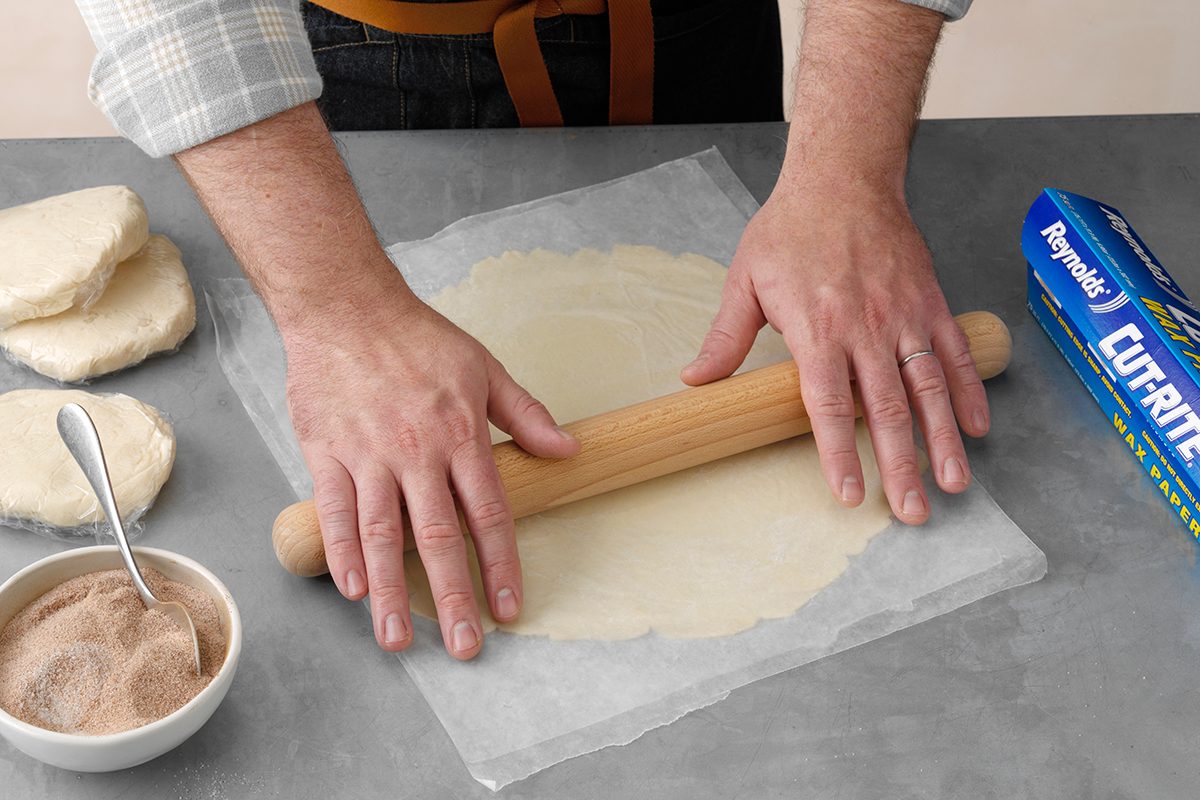
Not only are cutout cookies a major part of holiday baking traditions, but there are plenty of other delicious cutouts that I like to enjoy all year (these donut cookies are a particular favorite of mine).
But as much as I love to decorate these cookies and snack on them with my morning coffee, making them doesn’t always come easy—or at least rolling the cookie dough takes a certain bit of finesse (and muscle). To learn the ins and outs of how to roll out cookie dough easily and correctly, I chatted with cookie aficionado and Taste of Home Prep Kitchen Manager Catherine Ward. She filled me in on a few techniques that make the process easy.
Set Yourself Up for Success

Before you even mix up your cookie dough, Catherine recommends getting your kitchen prepped and making sure you have the gear you need.
“Make sure you give yourself plenty of elbow room,” Catherine says. Having enough room to roll out your dough and have your gear at hand is important. If your counter space is limited, move to the kitchen table or island—anywhere that’s easy to clean and has space to spare.
Also, make sure you’re ready with a good rolling pin. Which pin you choose is all personal preference—some people like the tapered French-style rolling pins and others prefer the old-fashioned kind with handles on the end. They all will get the job done, though Catherine suggests a heavier rolling pin with a good circumference for really heavy or firm doughs. That was a tip I loved hearing—my go-to pin is this marble option.
A few more extras to have on hand when rolling out cookies are waxed paper and a bit of flour for dusting your surface.
Chill Your Dough at Least Once

Cutout cookie dough recipes often call for the dough to be chilled for at least 30 minutes before breaking out the rolling pin. If you’re working with a large batch of cookie dough, divide it into a few portions. This will make rolling the dough more manageable.
After rolling out the dough, Catherine recommends popping your shapes back into the fridge for 15 minutes. “Dough warms up when it’s handled which can soften the defined edges of the cutout shapes.”
A short stay in the fridge will firm the cookies up and will set you up for decorating success.
Consistency Is Key

When it comes to the rolling of the dough, Catherine told me that consistency is key. “Having a consistent thickness helps the cookies bake evenly,” she says.
When you’re rolling, keep an eye on the dough; you don’t want one half of your dough paper-thin and the other half bulky.
If getting the thickness just right isn’t quite your forte, there are rolling pins out there that take out the guesswork and measuring. This one from Joseph & Joseph has rings that slide onto the ends of the pin. Choose the ones that match the thickness you’re trying to achieve and roll, roll, roll!
Go Easy on the Flour

Cutout cookie recipes often call for a lightly floured surface to keep the dough from sticking to your worktop. In this case, lightly is the operative word. Adding too much flour to your counter and rolling pin can make your cookies tough—”that’s a big no-no,” according to Catherine.
To make sure you have the most tender cookies possible, Catherine recommends rolling out cookie dough between two sheets of very lightly floured waxed paper. If you find that the dough is sticking to the waxed paper, slide the cookie dough and paper onto a baking sheet and pop it into the fridge for 15 minutes. This will firm up the dough and make removing the paper easier.
Be Careful with Your Cookie Cutters

Even after you’ve successfully rolled out your dough, there are still a couple of things to keep in mind, according to Catherine.
“Keep your cookies as close together as possible without overlapping,” says Catherine. “And use different sized cookie cutters to maximize every bit of dough you’ve rolled out.”
The point of keeping your cutouts close and your scraps minimal? It’s to prevent rerolling the dough as much as possible. “Rerolling can make some cookies tough,” according to Catherine—and no one wants tough sugar cookies.
So squeeze in as many cookie cutters as you can the first time around and roll your scrap pile just once. Any other trimmings can be popped onto a cookie sheet and baked. These little extras can serve as a snack or can be used in a cookie crumb crust for another recipe.
Once you’ve mastered how to roll out cookie dough, be sure to check out our Test Kitchen’s tips for making the best cutouts—from dough to decorations.
The post How to Roll Out Cookie Dough Like a Pro appeared first on Taste of Home.
Lisa Kaminski


